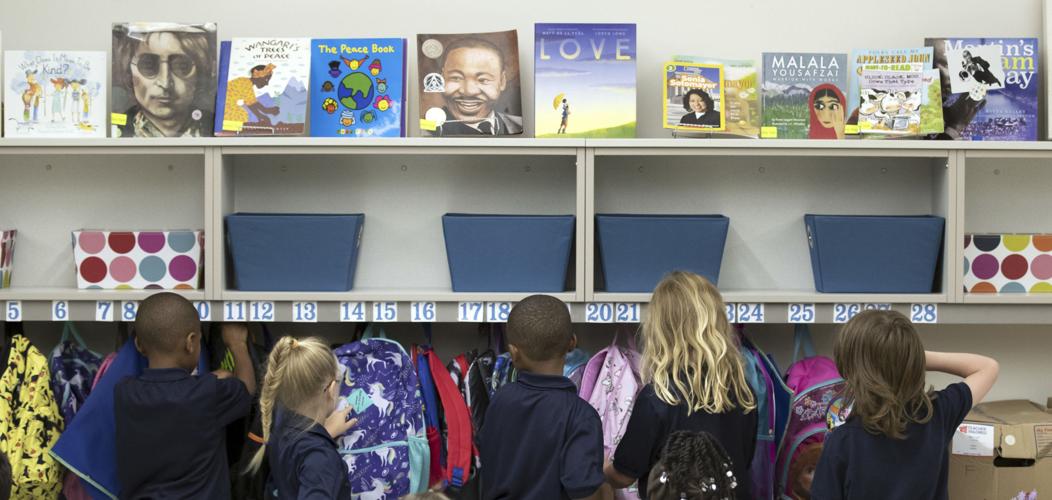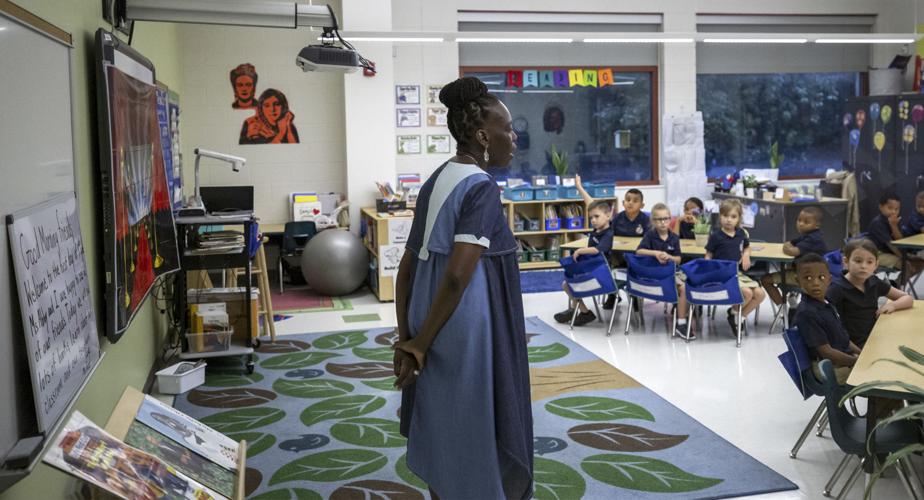Two decades ago, a group of frustrated New Orleans educators proposed a radical idea: start an open-enrollment charter school that would educate kids better by freeing the school from the bureaucracy of a poorly performing district.
The response was overwhelming. In its first year, about 900 applications came pouring in for just 117 spots at the school they created, New Orleans Charter Middle School.
That was in 1998. Fast-forward to today, and all of the city's public school students now attend charter schools as part of the nation's biggest experiment in education reform.
This summer, New Orleans officially became the first large American city to not offer a single traditional public school.
"We are embarking on a historic new chapter when it comes to public school education in America," Orleans Parish schools Superintendent Henderson Lewis Jr. said recently. "Since Katrina, we have been defining a new model for public education that has required innovation and a different way of thinking and approaching problems."
The colossal shift has come with promises nearly as big: to improve student performance, increase parental choice and spark innovation while holding charter organizations to a greater level of accountability.
Data from Tulane University show that in the past decade the charter movement in New Orleans has produced gains across several measures, including improved test scores. The number of students graduating from high school rose by between 3 and 9 percentage points from 2005 to 2014. Some surveys show that most parents attribute these gains to the proliferation of charter schools.
Yet New Orleans remains a city conflicted over how to educate its children.
Improved scores notwithstanding, some parents say the charter process has been disruptive. The closure of failing schools, for instance, has bounced kids to other schools, sometimes miles away from home, that don't necessarily perform much better.
In a survey conducted last year by Tulane University's Cowen Institute, which studies education in the city, only 39% of respondents said that they thought public schools were getting better in 2018.
Vincent Rossmeier, the Cowen Institute's policy director, says that's likely because student achievement on state tests in New Orleans has remained stagnant in the face of tougher tests and raised standards.
That, in turn, means few children still have access to schools that get top grades. Last year, only 14% of the city's students attended a school with an A grade. Another 16% went to a B school.
"The schools are improving, but there is still a perception that they're not at a level we want them to be," Rossmeier said. "We don’t have an A school in every neighborhood, and until we do we can’t say we’re the system that we want to be."
Parents' perceptions of the district's success have in the past been divided by race. Pointing to Cowen Institute reports, experts at Rutgers University noted in a 2019 paper that until recently more white than black residents had a favorable view of the charter schools.
"We argue that because black residents lost political power due to the state takeover of the public schools post-Katrina, they take into account the political costs of reform efforts when assessing the quality of their schools," the researchers, Domingo Morel and Sally Nuamah, wrote.
Some families of special-education students, meanwhile, say their children fall through the cracks because speech therapy, classes for gifted students or other services aren't always provided, or provided well. A single, centrally controlled district of schools, some experts say, is better equipped to deal with students with varying needs.
"Everyone is not having the same experience because all the schools are not alike. They vary greatly in terms of outcomes, culture and academic makeup," said Nahliah Webber, the executive director of the advocacy group Orleans Public Education Network, which lobbies for student equity. "So you're going to have very different opinions about how this is working out, based on where you are."
Large improvements
Although New Orleans' all-charter school district makes it unique, the city isn't alone in a move to charters in recent years. According to the National Charter School Resource Center, a research group funded in part by the U.S. Department of Education, charter schools now can be found in 42 states.
A 2017 report by the National Alliance for Public Charter Schools, an advocacy group, said that charter school enrollment had tripled over 12 years, to 3 million students. Altogether, there were 200 districts around the nation with at least 10 percent of public school students attending such a school.
Each state has its own laws dictating charter school governance, but in general the schools are independently run, publicly funded and tuition-free. Each school must have a contract that describes its mission, instructional program, personnel and other basics.
In New Orleans, there are currently 38 charter boards that play a role in the governance of about 80 local schools, according to the Cowen Institute.
They have autonomy over decisions ranging from staffing to curriculum. That marks the main difference between charters and schools in traditional districts, where a central staff of administrators makes most decisions for all schools in the district.
In New Orleans, the local district — now known as NOLA Public Schools — acts as a charter school "authorizer," meaning a small group of administrators decides which schools can open and which low-performing schools must close. It also sets policies for certain matters like funding formulas, expulsion procedures, facilities and the common enrollment process.
The state Department of Education allocates state funding approved annually by the Legislature and calculates grades for each school that reflect student performance.
Several parents who have gotten their kids into one of the seven Orleans charter schools that got an A rating last year — including the three that offered elementary schooling — have said that they're happy with the enrollment lottery.
Even some parents with kids in lower-rated schools say they're satisfied.
Sarah Parks, a 36-year-old social worker, has three children — 11-year-old Emma, 9-year-old Eli and 7-year-old Oliver — in Homer A. Plessy Community School, an arts-focused charter school that last year got a D from the state.
But Parks said she's not worried about the rating of the French Quarter school. She loves its arts-related curriculum and credits the charter system for allowing a school that doesn't ask kids to "fit into a box."
"It's a very diverse school and accommodating to different needs, and it fosters a really happy learning environment," Parks said. "And I do feel like regular public schools have been cutting back on the arts."
Charter schools began to proliferate beginning in 2003, when Louisiana Legislature created and voters approved the Recovery School District, a state-run district that was allowed to take over low-performing schools anywhere in Louisiana and either run them directly or convert them to charter schools.
Two years later, Hurricane Katrina hit, escalating the change. The storm and subsequent flooding destroyed the local school district, displacing students and sending teachers and staff scattering. Another legislative act, this one coming out of an emergency session after the hurricane, gave the RSD greater authority to take over troubled schools.
Over 100 schools in Orleans Parish were transferred to the RSD, and the local district laid off more than 7,000 teachers en masse because it no longer had jobs for them. The state subsequently handed those schools over to charter organizations.
The new system got rid of neighborhood schools and instead allowed families to apply to any school in the city. The schools received state funding based mostly on the number of students they attracted.
A 2018 analysis by the Education Research Alliance for New Orleans, a Tulane initiative that studies post-Katrina education in the city, found across-the-board improvement since all of those reforms were implemented.
Members of New Schools for New Orleans, a pro-charter nonprofit organization, have also said that the charter movement helped usher in major successes.
In 2005, 62% of New Orleans students attended Louisiana's lowest-performing schools, according to the group. By 2018, that percentage had dwindled to 8%.
In an interview, the organization's CEO, Patrick Dobard, credited progress to several measures. They include OneApp, the district's centralized enrollment system; a common expulsion process for all schools; and a funding formula that gives more money to students with special needs.
"We need to continue to push forward," Dobard said.
Normal lifestyle disrupted
Still, some parents aren't happy with the city's education shifts.
For years, 65-year-old Alex Lafurger said mornings were a special time for him and his son, Alongkorn. Every day since kindergarten, they two walked three blocks through the De Saix Boulevard neighborhood, wedged between Gentilly and St. Bernard, to the local school, Medard H. Nelson Charter.
But last year, when Alongkorn was in third grade, the district announced that Nelson's charter would be revoked from its parent organization, the New Beginnings Schools Foundation, because of poor academic performance.
Now, his son must travel by bus to New Orleans East to attend IDEA Oscar Dunn, a school that does not yet have a letter grade assigned to it because it's new as of the 2019-20 school year.
Most critics agree that New Orleans public schools, and the governing Orleans Parish School Board, were sadly lacking before the storm. But back then, parents didn't have to deal with sending their kids to schools scattered across the city, because there were neighborhood-based schools.
"Your social network is gone. Your friendship relations are gone. Your good feeling of going to a place you know is gone," Lafurger said of the transition. "His normal lifestyle is totally disrupted."
Ashana Bigard, a post-Katrina education reform critic who has children in two different public schools in the city, is unhappy with the new school governance model.
She said she doesn't trust that charter board members know how to run New Orleans schools effectively, given that members are not elected to their positions, aren't required to have an education background and don't always have to live in New Orleans.
A report by the Cowen Institute released in early August showed that in 2018, 19% of board members had legal backgrounds and nearly 18% worked in finance. On a leadership level, 80% were men. There was no data on race or residence.
"It makes me sad and angry," Bigard said. "It makes me sad because, as a parent who is not in $60,000-plus earning range, I don’t have the option to opt out and put my child in private school. It makes me angry because it’s an experiment. You're using our city as a laboratory."
Jay Altman, a longtime educator and the founder of New Orleans Charter Middle School, said charter schools have sparked much-needed reforms that would have been impossible under the bureaucratic system in place before.
But, he added, the decentralized system of charter schools has brought new challenges, too.
According to Altman, the local district is still wrestling with managing its portfolio of decentralized schools, and it must continue working with partners to improve opportunities for children with special needs.
The district will also have to figure out how to balance school independence with appropriate oversight, in order to better prevent the sort of malfeasance that's rocked the New Orleans education landscape more than once in recent years.
Finally, Altman and others note that while reform sparked rapid improvement after Katrina, school scores in recent years have plateaued.
Before Katrina, the district's schools collectively had a failing grade from the state Department of Education. New Orleans schools got a B rating in 2016 after getting C grades in 2014 and 2015 but then reverted to C for 2017 and 2018.
"Overall, the bottom line for all this, is we’ve made a lot of progress and still have a long way to go," Altman said.
Editor's note: This story has been changed to note that the Recovery School District was created in 2003 following voter approval.














